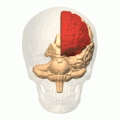Frontal lobe
Frontal lobe is the largest of the four major lobes of the brain in mammals, and is located at the front of each hemisphere. It is separated from the parietal lobe by a groove between tissues, the central sulcus, and from the temporal lobe by a deeper groove, the lateral sulcus.
Anatomy[edit]
The frontal lobe is the same general structure among mammals, but is significantly larger in humans than in other mammals. It is divided into two main areas – the precentral cortex, which is responsible for motor control, and the prefrontal cortex, which is responsible for executive functions such as self-control, planning, reasoning, and abstract thought.
Functions[edit]
The frontal lobe is involved in many functions of the brain, including:
- Motor skills: The frontal lobe includes the primary motor cortex, which is responsible for voluntary movement.
- Language: The frontal lobe is important for expressive language. Broca's area, located in the left frontal lobe, is involved in speech production.
- Executive functions: The frontal lobe is essential for tasks that require planning and decision making. It is also involved in personality and emotion through its connections with the limbic system.
Clinical significance[edit]
Damage to the frontal lobe can lead to a variety of disorders, including:
- Frontal lobe disorder: This is a condition where there is damage to the frontal lobes of the brain that can cause a variety of symptoms, including changes in personality, mood, and behavior.
- Phineas Gage: A famous case of frontal lobe damage. Gage survived an accident in which a large iron rod was driven completely through his head, but his personality changed dramatically.
- Frontotemporal dementia: This is a group of disorders characterized by the progressive atrophy of the frontal and temporal lobes of the brain.
See also[edit]
References[edit]
<references />
Ad. Transform your life with W8MD's Budget GLP-1 injections from $75


W8MD offers a medical weight loss program to lose weight in Philadelphia. Our physician-supervised medical weight loss provides:
- Weight loss injections in NYC (generic and brand names):
- Zepbound / Mounjaro, Wegovy / Ozempic, Saxenda
- Most insurances accepted or discounted self-pay rates. We will obtain insurance prior authorizations if needed.
- Generic GLP1 weight loss injections from $75 for the starting dose.
- Also offer prescription weight loss medications including Phentermine, Qsymia, Diethylpropion, Contrave etc.
NYC weight loss doctor appointmentsNYC weight loss doctor appointments
Start your NYC weight loss journey today at our NYC medical weight loss and Philadelphia medical weight loss clinics.
- Call 718-946-5500 to lose weight in NYC or for medical weight loss in Philadelphia 215-676-2334.
- Tags:NYC medical weight loss, Philadelphia lose weight Zepbound NYC, Budget GLP1 weight loss injections, Wegovy Philadelphia, Wegovy NYC, Philadelphia medical weight loss, Brookly weight loss and Wegovy NYC
|
WikiMD's Wellness Encyclopedia |
| Let Food Be Thy Medicine Medicine Thy Food - Hippocrates |
Medical Disclaimer: WikiMD is not a substitute for professional medical advice. The information on WikiMD is provided as an information resource only, may be incorrect, outdated or misleading, and is not to be used or relied on for any diagnostic or treatment purposes. Please consult your health care provider before making any healthcare decisions or for guidance about a specific medical condition. WikiMD expressly disclaims responsibility, and shall have no liability, for any damages, loss, injury, or liability whatsoever suffered as a result of your reliance on the information contained in this site. By visiting this site you agree to the foregoing terms and conditions, which may from time to time be changed or supplemented by WikiMD. If you do not agree to the foregoing terms and conditions, you should not enter or use this site. See full disclaimer.
Credits:Most images are courtesy of Wikimedia commons, and templates, categories Wikipedia, licensed under CC BY SA or similar.
Translate this page: - East Asian
中文,
日本,
한국어,
South Asian
हिन्दी,
தமிழ்,
తెలుగు,
Urdu,
ಕನ್ನಡ,
Southeast Asian
Indonesian,
Vietnamese,
Thai,
မြန်မာဘာသာ,
বাংলা
European
español,
Deutsch,
français,
Greek,
português do Brasil,
polski,
română,
русский,
Nederlands,
norsk,
svenska,
suomi,
Italian
Middle Eastern & African
عربى,
Turkish,
Persian,
Hebrew,
Afrikaans,
isiZulu,
Kiswahili,
Other
Bulgarian,
Hungarian,
Czech,
Swedish,
മലയാളം,
मराठी,
ਪੰਜਾਬੀ,
ગુજરાતી,
Portuguese,
Ukrainian




